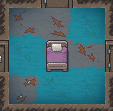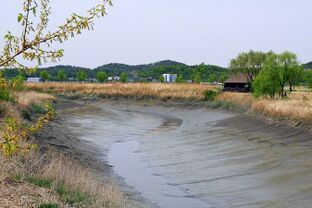- v50 information can now be added to pages in the main namespace. v0.47 information can still be found in the DF2014 namespace. See here for more details on the new versioning policy.
- Use this page to report any issues related to the migration.
Difference between revisions of "Mud"
LethosorBot (talk | contribs) (Tagging v50 page (2965/4888)) |
(Added image.) |
||
| (4 intermediate revisions by 3 users not shown) | |||
| Line 1: | Line 1: | ||
| − | + | {{Quality|Superior}} | |
| − | {{Quality| | ||
{{av}} | {{av}} | ||
| − | + | [[File:mud_sprite_preview.png|right]]'''Mud''' is a [[contaminant]] produced when an area is covered with [[water]], and colors tiles brown. It is essentially just running wet dirt. Mud also occurs naturally in deep [[cavern|caverns]]. Muddied stone can be used for [[farming]], [[Pasture|grazing]], [[Herbalist|plant gathering]], and [[Tree#Growing_trees|growing subterranean trees]]. "A pile of mud" in water sources can result in "[[Water#Water_laced_with_mud|water laced with mud]]" which can lead to problems if your dwarves use it. | |
| − | [[File: | ||
''Note: Upon [[reclaim fortress mode|reclaiming a fortress]], '''every single bit of mud will disappear''', including even mud in the caverns.'' | ''Note: Upon [[reclaim fortress mode|reclaiming a fortress]], '''every single bit of mud will disappear''', including even mud in the caverns.'' | ||
| Line 11: | Line 9: | ||
== Farming and spontaneous growth on mud == | == Farming and spontaneous growth on mud == | ||
| − | The plants that can be [[farming|farmed]] on mud are the same as those that would grow on soil in the same place. Biome-appropriate grass (useful for [[Pasture|grazing]]) and plants (and, if underground, trees) will also spontaneously grow on muddy stone just like any other soil tile. [[Tile_attributes|Above-ground]] plants can't grow or be farmed on underground tiles, and vice versa, though tiles can be made permanently "above-ground" by exposing them to light. And perhaps unfortunately, muddying stone won't allow farming of different above-ground crops from other biomes. Note that underground plants won't spontaneously grow until a [[cavern]] has been breached, though farming from seeds is still possible. Note also that saplings need more than 1 z-level to mature into adult, wood-bearing trees | + | The plants that can be [[farming|farmed]] on mud are the same as those that would grow on soil in the same place. Biome-appropriate grass (useful for [[Pasture|grazing]]) and plants (and, if underground, trees) will also spontaneously grow on muddy stone just like any other soil tile. [[Tile_attributes|Above-ground]] plants can't grow or be farmed on underground tiles, and vice versa, though tiles can be made permanently "above-ground" by exposing them to light. And perhaps unfortunately, muddying stone won't allow farming of different above-ground crops from other biomes. Note that underground plants won't spontaneously grow until a [[cavern]] has been breached, though farming from seeds is still possible. Note also that saplings need more than 1 z-level to mature into adult, wood-bearing trees (see [[tree farming]] for more). |
Constructed floors behave differently - plants won't spontaneously grow on them, but farms will grow fine. Muddied smoothed floors might behave differently from muddied rough floors also, but more information is needed.{{verify}} | Constructed floors behave differently - plants won't spontaneously grow on them, but farms will grow fine. Muddied smoothed floors might behave differently from muddied rough floors also, but more information is needed.{{verify}} | ||
== Muddying areas == | == Muddying areas == | ||
| − | |||
See [[irrigation]] for some methods. One common way of creating mud is to [[irrigation|flood]] a good-sized area from a lake, thus making mud. Another way is to use a pit/pond from the [[Activity zone|activity zone menu]] and have a dwarf throw water over a channeled area into a dug-out area below. | See [[irrigation]] for some methods. One common way of creating mud is to [[irrigation|flood]] a good-sized area from a lake, thus making mud. Another way is to use a pit/pond from the [[Activity zone|activity zone menu]] and have a dwarf throw water over a channeled area into a dug-out area below. | ||
| Line 24: | Line 21: | ||
== Removing mud == | == Removing mud == | ||
| − | |||
Mud can be removed by constructing something over the mud (including furniture), then deconstructing it, or by smoothing/engraving stone. Mud on soil is removed easily by constructing a dirt road. | Mud can be removed by constructing something over the mud (including furniture), then deconstructing it, or by smoothing/engraving stone. Mud on soil is removed easily by constructing a dirt road. | ||
| Line 32: | Line 28: | ||
== Muddy water == | == Muddy water == | ||
| − | + | [[File:mud_in_bedroom.png|thumb|113px|right|Mud in a bedroom, tracked in by dirty water.]]Using "water laced with mud" can cause health and happiness problems, see the [[Water#Water_laced_with_mud|water page]] for more details. Drinking muddy water is better than dying of thirst, though. | |
| − | Using "water laced with mud" can cause health and happiness problems, see the [[Water#Water_laced_with_mud|water page]] for more details. Drinking muddy water is better than dying of thirst, though. | ||
Dug-out reservoirs should be able to store water without contaminating it with mud, since initial flooding with water leaves only "a dusting of mud". However, under some circumstances the reservoir can end up with piles of mud on its floor anyway, especially if slowly filled using buckets. (more information needed.) | Dug-out reservoirs should be able to store water without contaminating it with mud, since initial flooding with water leaves only "a dusting of mud". However, under some circumstances the reservoir can end up with piles of mud on its floor anyway, especially if slowly filled using buckets. (more information needed.) | ||
| Line 39: | Line 34: | ||
Natural [[cavern]] pools have floors covered with "a pile of mud", so make sub-optimal water sources, unless they're deep enough that water can be drawn from a tile that doesn't contain "a pile of mud". | Natural [[cavern]] pools have floors covered with "a pile of mud", so make sub-optimal water sources, unless they're deep enough that water can be drawn from a tile that doesn't contain "a pile of mud". | ||
| − | + | === A dusting of mud === | |
| + | "A dusting of mud" is always displayed even when pumping clean water onto the floor. This water is completely sufficient to drink, and acts the same as clean water. | ||
| + | [[File:mud2.jpg|thumb|312px|center|Not fit for wearing your best shoes.]] | ||
{{Translation | {{Translation | ||
| dwarven = ol | | dwarven = ol | ||
Latest revision as of 18:17, 14 March 2024
v52.04 · v0.47.05 This article is about the current version of DF.Note that some content may still need to be updated. |
Mud is a contaminant produced when an area is covered with water, and colors tiles brown. It is essentially just running wet dirt. Mud also occurs naturally in deep caverns. Muddied stone can be used for farming, grazing, plant gathering, and growing subterranean trees. "A pile of mud" in water sources can result in "water laced with mud" which can lead to problems if your dwarves use it.
Note: Upon reclaiming a fortress, every single bit of mud will disappear, including even mud in the caverns.
Mud men are (obviously) made of mud, as are titans, forgotten beasts, and demons on occasion.
Farming and spontaneous growth on mud[edit]
The plants that can be farmed on mud are the same as those that would grow on soil in the same place. Biome-appropriate grass (useful for grazing) and plants (and, if underground, trees) will also spontaneously grow on muddy stone just like any other soil tile. Above-ground plants can't grow or be farmed on underground tiles, and vice versa, though tiles can be made permanently "above-ground" by exposing them to light. And perhaps unfortunately, muddying stone won't allow farming of different above-ground crops from other biomes. Note that underground plants won't spontaneously grow until a cavern has been breached, though farming from seeds is still possible. Note also that saplings need more than 1 z-level to mature into adult, wood-bearing trees (see tree farming for more).
Constructed floors behave differently - plants won't spontaneously grow on them, but farms will grow fine. Muddied smoothed floors might behave differently from muddied rough floors also, but more information is needed.[Verify]
Muddying areas[edit]
See irrigation for some methods. One common way of creating mud is to flood a good-sized area from a lake, thus making mud. Another way is to use a pit/pond from the activity zone menu and have a dwarf throw water over a channeled area into a dug-out area below.
Initial water contact with a clean surface will leave "a dusting of mud", not "a pile of mud". This is sufficient for farming and grazing, but not enough to cause any water-contamination problems in reservoirs.
Dumping water on an already-muddy area may result in more mud accumulating there, up to "a pile of mud".
Removing mud[edit]
Mud can be removed by constructing something over the mud (including furniture), then deconstructing it, or by smoothing/engraving stone. Mud on soil is removed easily by constructing a dirt road.
Dwarves will not clean mud as a cleaning labor, though they will at least sometimes clean blood and possibly other contaminants from muddied surfaces. (needs more info)
Magma will remove mud if it evaporates on a tile.
Muddy water[edit]
Using "water laced with mud" can cause health and happiness problems, see the water page for more details. Drinking muddy water is better than dying of thirst, though.
Dug-out reservoirs should be able to store water without contaminating it with mud, since initial flooding with water leaves only "a dusting of mud". However, under some circumstances the reservoir can end up with piles of mud on its floor anyway, especially if slowly filled using buckets. (more information needed.)
Natural cavern pools have floors covered with "a pile of mud", so make sub-optimal water sources, unless they're deep enough that water can be drawn from a tile that doesn't contain "a pile of mud".
A dusting of mud[edit]
"A dusting of mud" is always displayed even when pumping clean water onto the floor. This water is completely sufficient to drink, and acts the same as clean water.
"Mud" in other Languages
|
Raws |
|---|
[MATERIAL:MUD] - reconstructed from data extracted from memory
[STATE_COLOR:ALL:BROWN]
[STATE_NAME_ADJ:ALL_SOLID:mud]
[STATE_NAME_ADJ:SOLID_POWDER:dirt]
[STATE_NAME_ADJ:SOLID_PRESSED:pressed dirt]
[BASIC_COLOR:6:0]
[BUILD_COLOR:6:0:0]
[TILE_COLOR:7:7:1]
[SPEC_HEAT:800]
[SOLID_DENSITY:1200] |
| More: Gems • Metals • Stones | |
| Creature | |
| Plant | |
| Creature/Plant |
Alcohol • Cloth/Thread • Extract (Golden salve • Gnomeblight • Honey • Royal jelly • Syrup • Venom) • Glob • Liquids • Soap |
| Inorganic |
Metal • Milk of lime • Soil (Clay • Sand) • Stone (Ash glaze • Earthenware • Gem • Gypsum plaster • Porcelain • Quicklime • Stoneware • Tin glaze) |
| Hardcoded | |
| Glitch | |
| See also: Material science | |

